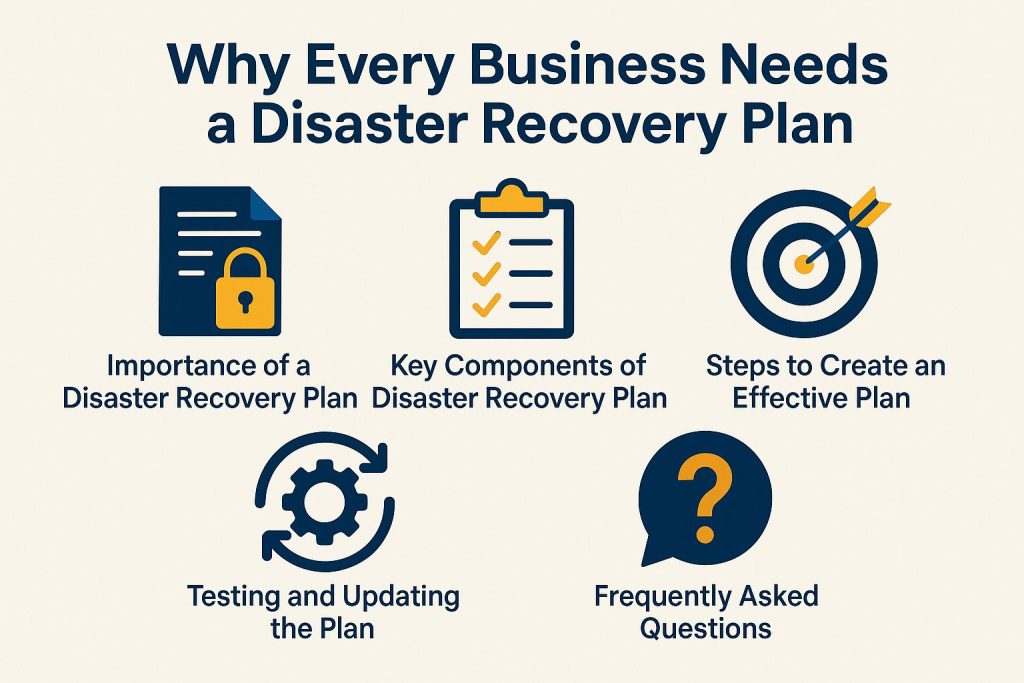Why Every Business Needs a Disaster Recovery Plan

Disasters can harm businesses. A good disaster recovery plan is essential. It helps protect business operations and valuable data. This article explains why disaster recovery is important. It lists key parts and gives steps to create a strong plan.
Why a Disaster Recovery Plan is Important
A disaster recovery plan can cut downtime by up to 50%. This keeps important functions running during disruptions. For example, Target’s 2013 data breach cost over $200 million in recovery. Curious about why your business needs a proactive IT security strategy? Our analysis explains key factors to consider.

Protecting Business Continuity
Actions like setting up backup data centers and regular training help businesses prepare for emergencies.
In contrast, organizations with robust disaster recovery plans can quickly restore data and services, thereby minimizing disruptions and financial losses.
By assessing potential risks and investing in proactive measures, companies can effectively safeguard their essential functions and maintain operational efficiency even during crises.
Safeguarding Data and Assets
Data integrity is crucial. Businesses with good backup solutions can often recover from data loss in under 24 hours. Veeam and Acronis are two strong options.
Veeam costs $42 per month. It offers features like instant file recovery and is great for virtual environments.
Conversely, Acronis costs $49.99 per year. It offers backup and cyber protection against threats like ransomware. Related insight: Proactive IT Security Strategy for Business Success can further enhance your organization’s data protection approach.
Organizations should carefully assess their specific requirements, taking into account factors such as data volume and recovery time objectives, to select the most suitable solution for their needs.
Key Components of a Disaster Recovery Plan
A good disaster recovery plan has key parts. These include risk assessments to identify threats and ways to recover.
Establishing Recovery Time Objectives (RTO) helps decide how quickly to restore systems. Recovery Point Objectives (RPO) define acceptable data loss.
Regularly scheduled drills can be utilized to test these components, enabling organizations to refine their plans and ensure quick adaptation in real scenarios. In particular, implementing cybersecurity best practices can further enhance these strategies – elaborating on how they integrate with disaster recovery plans offers valuable insights for small businesses.
Steps to Create an Effective Plan
To create a disaster recovery plan, follow these steps: First, conduct a business impact analysis. This takes one to two weeks. Next, identify critical functions and resources. This usually takes about a week.
Following this, it is essential to develop recovery strategies tailored to specific needs. This may include data backups or alternate operational sites and might take two to three weeks.
Document procedures clearly. Allow about one week for writing and reviews.
Finally, conducting training sessions for relevant employees is necessary, with a one-week schedule aimed at ensuring that everyone is adequately prepared.
Testing and Updating the Plan
Regularly test and update the disaster recovery plan. This ensures it works well during crises. Use scenario planning and disaster recovery testing. Conduct disaster recovery drills and simulations at least once a year. This helps identify vulnerabilities and boosts team readiness. It also promotes process improvement and risk reduction.
Organizations should use tools like DR Testing. These tools help with planning and execution through scenario development and feedback. After a simulation, gather insights. Assess response times and document lessons learned.
Use these findings to revise the recovery plan. This improvement cycle strengthens the response strategy and builds a culture of preparedness. Those curious about the broader aspects of maintaining operational security might appreciate exploring cybersecurity best practices for small businesses.
Frequently Asked Questions
What is a disaster recovery plan and why does every business need one?
A disaster recovery plan is a written process. It outlines how a business will respond to and recover from disasters. It includes resource allocation and incident documentation. Every business needs a plan to minimize disruption and protect critical data and assets during a disaster.
What are the benefits of having a disaster recovery plan in place?
A disaster recovery plan offers many benefits. It minimizes downtime, reduces financial losses, maintains customer trust, and helps comply with cybersecurity regulations.
What are the key components of a disaster recovery plan?
A disaster recovery plan typically includes: a risk assessment, a business impact analysis, emergency response procedures, a communication plan, backup and recovery processes, and a testing schedule. This ensures comprehensive incident response.
How often should a disaster recovery plan be reviewed and updated?
Review and update the disaster recovery plan at least once a year. Update it whenever there are significant business changes, like new systems, personnel changes, or regulatory updates.
What should be included in a communication plan for a disaster recovery plan?
A communication plan should include contact information for key personnel, emergency response teams, vendors, and customers. It should outline how to maintain communication during a disaster. Specify who has the authority to make critical decisions about the plan.
Can a disaster recovery plan be outsourced to a third-party provider?
Yes, many businesses outsource disaster recovery planning and management to third-party providers. These providers specialize in disaster recovery services. This ensures a comprehensive plan and provides access to expert support during a disaster.




